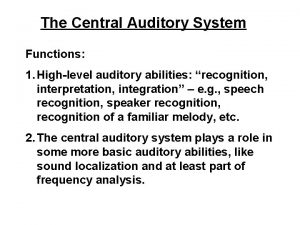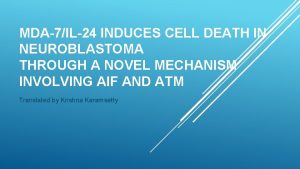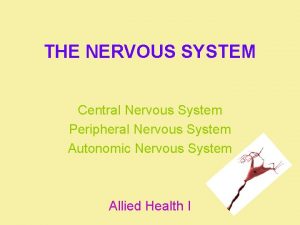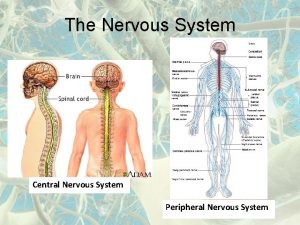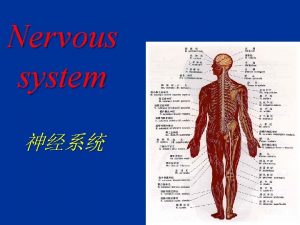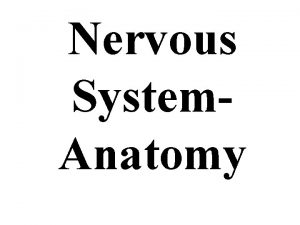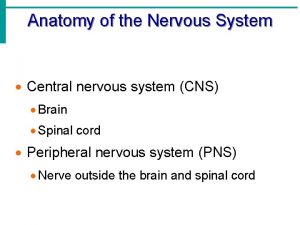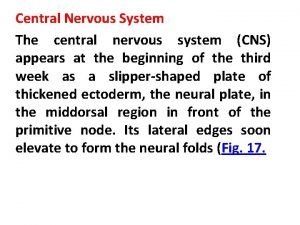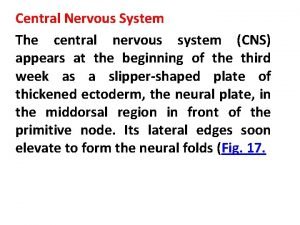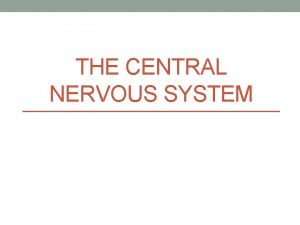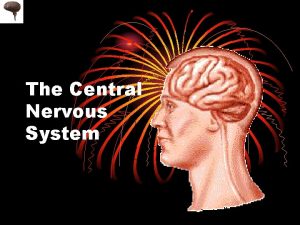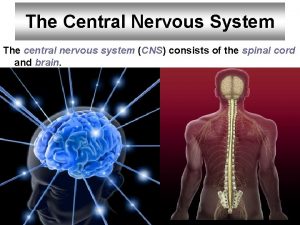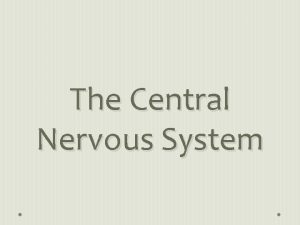Anatomy Physiology Central Nervous System Chapter 12 Part























































- Slides: 55

Anatomy & Physiology Central Nervous System Chapter 12 Part 1

Brain Development Posteriolateral growth of the cerebral hemispheres encloses the diencephalon and superior aspect of the brain stem

Embryo at four weeks http: //w-cpc. org/fetal 1. html

Embryonic Development Ectoderm thickens along dorsal midline to form the neural plate The neural plate invaginates, forming a neural groove flanked by neural folds The neural groove fuses dorsally and forms the neural tube which detaches from the surface ectoderm. The neural tube differentiates into the CNS. Neural crest cells form some PNS structures.

Embryonic Development

Neural Tube and Primary Brain Vesicles The anterior (rostral) end of the neural tube expands and forms the three primary brain vesicles Prosencephalon Mesencephalon Rhombencephalon

Secondary Brain Vesicles In week 5 of embryonic development, secondary brain vesicles form Telencephalon and Diencephalon arise from the prosenencephalon Mesencephalon remains undivided Metencephalon and Myelencephalon arise from the rhombencephalon

Adult Brain Structures Secondary brain vesicles differentiate into adult brain structures Telencephalon – cerebrum: cortex, white matter, and basal nuclei Diencephalon – thalamus, hypothalamus Mesencephalon – brain stem: midbrain Metencephalon – brain stem: pons Myelencephalon – brain stem: medulla oblongata

Adult Brain Structures

Adult Neural Canal Regions The central cavity of the neural tube enlarges in four regions to form fluid-filled Ventricles Telencephalon – Lateral Ventricles Diencephalon – Third Ventricle Mesencephalon – Cerebral Aqueduct Metencephalon & Myelencephalon – Fourth Ventricle Spinal Cord – Central Canal

Adult Neural Canal Regions

Ventricles of the Brain Pair of C-shaped Lateral Ventricles Third Ventricle in the diencephalon Fourth Ventricle in the hindbrain dorsal to the pons

Cerebral Hemispheres Form the superior part of the brain and make up over 80% of its mass Surface Features: Ridges called Gyri (gyrus) Shallow grooves called Sulci (sulcus) Deeper grooves called Fissures Hemispheres are separated by the Longitudinal fissure and from cerebellum by the Transverse Cerebral fissure

Cerebral Hemispheres - Lobes Frontal, Parietal, Temporal, Occipital, and (Insula) Central sulcus – separates the frontal and parietal lobes Parieto-occipital sulcus – separates the parietal and occipital lobes Lateral sulcus – separates the parietal and temporal lobes

Cerebral Hemispheres – 3 basic regions Cortex – superficial gray matter, 1 -4. 5 mm thick White matter – inner, unmyelinated Basal Nuclei – islands of gray matter within the white matter Cortex (40% of brain mass) consists of neuron cell bodies, dendrites, and unmyelinated axons (plus glial cells and blood vessels), no fiber tracts, all neurons are interneurons

Cerebral Cortex Enables sensation, communication, memory, understanding, and voluntary movements Each hemisphere controls the opposite (contralateral) side of the body Hemispheres are not functionally equivalent (lateralization or specialization of cortical functions) No functional area acts alone - conscious behavior involves the entire cortex

Cerebral Cortex Three kinds of functional areas: Motor areas – control voluntary movement Sensory areas – conscious awareness of sensation Association areas – integrate diverse information, communicate “associate” with the motor cortex and sensory association areas to analyze input

Cerebral Cortex

Cerebral Cortex

Cerebral Cortex: Motor Areas Primary (somatic) motor cortex Premotor cortex Broca’s area Frontal eye field

Primary Motor Cortex Located in the precentral gyrus of the frontal lobe Allows conscious control of voluntary movements Composed of neurons called pyramidal cells axons project to spinal cord and make up the voluntary motor tracts called corticospinal tracts

Primary Motor Cortex Motor homunculus – caricature of relative amounts of cortical tissue devoted to each motor function

Premotor Cortex Located anterior to the precentral gyrus Controls learned, repetitious, or patterned motor skills Coordinates simultaneous or sequential actions( directly or indirectly) Involved in the planning of movements

Broca’s Area Located anterior to the inferior region of the premotor area Present in one hemisphere (usually the left) A motor speech area that directs muscles involved in speech Is active as one prepares to speak

Frontal Eye Field Located anterior to the premotor cortex and superior to Broca’s area Controls voluntary eye movement

Sensory Areas Primary somatosensory cortex Somatosensory association cortex Visual and auditory areas Olfactory, gustatory, and vestibular cortices

Primary Somatosensory Cortex Located in the postcentral gyrus of the parietal lobe Receives information from somatic sensory receptors in the skin and proprioceptors in skeletal muscles Exhibits spatial discrimination

Primary Somatosensory Cortex Somatosensory homunculus – caricature of relative amounts of cortical tissue devoted to each sensory function

Somatosensory Association Cortex Located posterior to the primary somatosensory cortex Integrates sensory information coming from the primary somatosensory cortex to produce an understanding (size, texture, and relationship of parts) of the stimulus

Visual Areas Primary visual (striate) cortex - located on the posterior tip of the occipital lobe, most of it is buried in the calcarine sulcus - receives visual information from the retinas Visual association area - surrounds the primary visual cortex - interprets visual stimuli (e. g. , color, form, and movement)

Auditory Areas Primary auditory cortex - located in the superior margin of the temporal lobe -receives information related to pitch, rhythm, and loudness Auditory association area - located posterior to the primary auditory cortex -stores memories of sounds and permits perception of sounds

Other Sensory Areas Olfactory (smell) cortex – small area of frontal lobe above the orbit and in medial temporal lobe (piriform lobe and uncus) Gustatory (taste) cortex – in parietal lobe deep to temporal lobe

Other Association Areas Prefrontal cortex Language areas General (common) interpretation area Visceral association area

Prefrontal Cortex Located in the anterior portion of the frontal lobe Involved with intellect, cognition, recall, personality, judgment, reasoning, and conscience Closely linked to the limbic system (emotional part of the brain)

Language Areas Broca’s area Wernicke’s area Located in a large area surrounding the left (or languagedominant) lateral sulcus Broca’s area – speech preparation and production Wernicke’s area – involved in sounding out unfamiliar words Lateral prefrontal cortex – language comprehension and word analysis. Lateral and ventral temporal lobe – coordinate auditory and visual aspects of language

General (Common) Interpretation Area (? ) Ill-defined region including parts of the temporal, parietal, and occipital lobes Found in one hemisphere, usually the left Integrates incoming signals into a single thought Involved in processing spatial relationships Visceral Association Area (? ) Located in the cortex of the insula Involved in conscious perception of visceral sensations

Lateralization of Cortical Function Lateralization – each hemisphere has abilities not shared with the other hemisphere Cerebral dominance – designates the hemisphere dominant for language Left hemisphere – controls language, math, and logic Right hemisphere – controls visual-spatial skills, emotion, and artistic skills

Cerebral White Matter Consists of myelinated fibers and their tracts Responsible for communication between areas of the cerebrum amd between the cerebral cortex and lower CNS centers

Cerebral White Matter Fiber Tracts Commissures – connect corresponding gray areas of the two hemispheres (corpus callosum , anterior and posterior commissures) Association fibers – connect different parts of the same hemisphere Projection fibers – enter the hemispheres from lower brain or cord centers Commissures and Association fibers – horizontal Projection fibers – vertical

Fiber Tracts in White Matter

Fiber Tracts in White Matter

Basal Nuclei Masses of gray matter found deep within the cortical white matter Corpus striatum: Caudate nucleus (amygdala- tail of caudate) Lentiform nucleus – composed of the putamen and the globus pallidus Fibers of internal capsule run between and through caudate and lentiform nuclei, giving them a striped appearance

Basal Nuclei

Basal Nuclei

Functions of Basal Nuclei Possible functions of basal nuclei: Influence muscular activity Regulate attention and cognition Regulate intensity of slow or stereotyped movements Inhibit antagonistic and unnecessary movement

Diencephalon and Brain Stem

Diencephalon Central core of the forebrain surrounded by the cerebral hemispheres Consists of three paired structures – thalamus, hypothalamus, and epithalamus Collectively, these gray matter areas enclose third ventricle

Thalamus Paired, egg-shaped masses that form the superolateral walls of the third ventricle Connected at the midline by the interthalamic adhesion (intermediate mass) Contains four groups of nuclei - anterior, ventral, dorsal, and posterior - project and receive fibers from the cerebral cortex

Thalamus

Thalamus – “gateway” to the cerbral cortex Afferent impulses from all senses converge and synapse in the thalamus Impulses of similar function are sorted out, “edited”, and relayed as a group to the appropriate area of the sensory cortex or association areas All inputs ascending to the cerebral cortex pass through the thalamus Plays a key role in mediating sensation, motor activities, cortical arousal, learning, and memory

Hypothalamus Below the thalamus, it caps the brainstem and forms the inferolateral walls of the third ventricle Mammillary bodies - small, paired nuclei bulging anteriorly from the hypothalamus - relay stations for olfactory pathways Infundibulum – stalk of the hypothalamus connecting to the pituitary gland Main visceral control center of the body, important to overall body homeostasis

Hypothalamic Nuclei

Hypothalamic Function Regulates ANS by controlling activity of centers in brains stem and spinal cord Regulates blood pressure, rate and force of heartbeat, digestive tract motility, respiratory rate and depth, pupil size, and many other visceral activities Center for emotional response - involved in perception of pleasure, fear, rage Regulates body temperature – the body’s “thermostat” Regulates food intake - feelings of hunger and satiety Regulates sleep-wake cycle

Endocrine Functions of the Hypothalamus Releasing hormones control the secretion of hormones by the anterior pituitary Stimulates ADH release from the posterior pituitary Anti-diuretic hormone- causes kidneys to retain water

Epithalamus Most dorsal portion of the diencephalon; forms roof of the third ventricle Pineal gland – extends from the posterior border and secretes melatonin, a hormone involved with sleep regulation, sleep-wake cycles, and mood Choroid plexus – a structure that secretes cerebral spinal fluid (CSF) [all ventricles have a choroid plexus]
 Central nervous system parts
Central nervous system parts Anatomy and physiology chapter 8 skeletal system
Anatomy and physiology chapter 8 skeletal system Fundamentals of the nervous system and nervous tissue
Fundamentals of the nervous system and nervous tissue Fundamentals of the nervous system and nervous tissue
Fundamentals of the nervous system and nervous tissue Processes of neuron
Processes of neuron Anatomy and physiology unit 7 cardiovascular system
Anatomy and physiology unit 7 cardiovascular system Types of respiration in human
Types of respiration in human Chapter 14 anatomy and physiology
Chapter 14 anatomy and physiology Waistline
Waistline Anatomy and physiology chapter 8 special senses
Anatomy and physiology chapter 8 special senses Chapter 13 anatomy and physiology of pregnancy
Chapter 13 anatomy and physiology of pregnancy Chapter 2 basic chemistry anatomy and physiology
Chapter 2 basic chemistry anatomy and physiology Heat and cold
Heat and cold Anatomy and physiology coloring workbook figure 14-1
Anatomy and physiology coloring workbook figure 14-1 Chapter 10 blood anatomy and physiology
Chapter 10 blood anatomy and physiology Anatomy and physiology chapter 15
Anatomy and physiology chapter 15 Anatomy and physiology chapter 1
Anatomy and physiology chapter 1 Holes anatomy and physiology chapter 1
Holes anatomy and physiology chapter 1 Anatomy and physiology chapter 15
Anatomy and physiology chapter 15 Medial and lateral
Medial and lateral Chapter 2 human reproductive anatomy and physiology
Chapter 2 human reproductive anatomy and physiology Chapter 6 general anatomy and physiology
Chapter 6 general anatomy and physiology Chapter 1 an introduction to anatomy and physiology
Chapter 1 an introduction to anatomy and physiology Major division
Major division Central nervous system amusement park
Central nervous system amusement park Nervous system vocabulary
Nervous system vocabulary Central and peripheral nervous system
Central and peripheral nervous system Central auditory nervous system
Central auditory nervous system What does this graph show
What does this graph show Central nervous system for kids
Central nervous system for kids 5 functions of the respiratory system
5 functions of the respiratory system Tattoo anatomy and physiology
Tattoo anatomy and physiology International anatomy olympiad
International anatomy olympiad Structure anatomy and physiology in agriculture
Structure anatomy and physiology in agriculture Anatomy and physiology bones
Anatomy and physiology bones Anatomy and physiology of peptic ulcer ppt
Anatomy and physiology of peptic ulcer ppt Cantlie line
Cantlie line Hypogastric region
Hypogastric region Wpigastric region
Wpigastric region Google com
Google com Endomysium
Endomysium Http://anatomy and physiology
Http://anatomy and physiology Appendix physiology
Appendix physiology Aohs foundations of anatomy and physiology 1
Aohs foundations of anatomy and physiology 1 Aohs foundations of anatomy and physiology 1
Aohs foundations of anatomy and physiology 1 Anatomical planes
Anatomical planes Unit 26 agriscience
Unit 26 agriscience Science olympiad forensics cheat sheet
Science olympiad forensics cheat sheet Liver anatomy and physiology ppt
Liver anatomy and physiology ppt Anatomy and physiology of pancreas in diabetes
Anatomy and physiology of pancreas in diabetes Aohs foundations of anatomy and physiology 1
Aohs foundations of anatomy and physiology 1 Aohs foundations of anatomy and physiology 1
Aohs foundations of anatomy and physiology 1 Anatomy and physiology
Anatomy and physiology Cornell notes for anatomy and physiology
Cornell notes for anatomy and physiology Human anatomy & physiology edition 9
Human anatomy & physiology edition 9 Holes essential of human anatomy and physiology
Holes essential of human anatomy and physiology



























